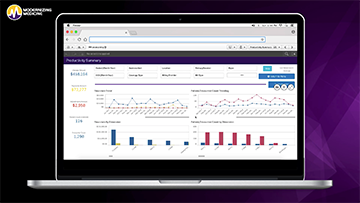How and Why You Should Consider Changing Your Practice Management System

The decision to switch practice management solutions can be difficult, but here’s why you should keep calm and carry on.
The word “change” may elicit feelings of apprehension, uncertainty and concern while simultaneously experiencing excitement and hopefulness. “Change” is a simple, six-letter word that signals different feelings for different people, and these feelings can easily switch based on what the change involves. One thing that rings true is that at some point or another, change becomes inevitable.
Now, what about change in the context of the medical field? Surgical techniques, treatment options, drugs and technological innovations have all evolved over the years, and most adjustments have been for the better. In order to keep up with the shifting demands from the industry, government and patients, you need to have the right technology in place to help your practice stay up to date and run as smoothly as possible.
One key piece of technology for your medical practice is a modern practice management system. At the end of the day, your medical practice is a business, and you need the best practice management system for your practice in place to truly reap the benefits.
What Is Practice Management Software?
According to Techopedia.com, practice management software (PMS) is defined as:
A form of software found in medical offices that is designed to deal with day-to-day operations using desktop software, client-server software and Internet-based software. PMS is generally used for financial and administrative functions, although it sometimes ties in with electronic medical records (EMR) based on varying medical practices’ needs.
 Based on my experience in the industry, the ideal practice management system should help revolutionize office workflow and patient payment collection. When I have asked our clients what they wanted in an ideal system, the overwhelming response was an all-in-one solution that could combine scheduling, document management, billing and reporting into one user-friendly solution that integrated with our own specialty EHR system, EMA
Based on my experience in the industry, the ideal practice management system should help revolutionize office workflow and patient payment collection. When I have asked our clients what they wanted in an ideal system, the overwhelming response was an all-in-one solution that could combine scheduling, document management, billing and reporting into one user-friendly solution that integrated with our own specialty EHR system, EMA . Sound like something on your wishlist? If so, it may be time to start evaluating a new practice management vendor.
. Sound like something on your wishlist? If so, it may be time to start evaluating a new practice management vendor.
Why It May Be Time to Switch Your Practice Management System
Utilizing an outdated practice management solution can result in inefficiencies while creating more work for your team and negatively affecting your cash flow. Here are some signs that the time has arrived to consider other solutions.
If any of these characteristics seem to describe your current medical practice management, it may be time to make a change—for the better.
- It doesn’t integrate with your current electronic health record (EHR) system.
- It isn’t equipped for your medical specialty.
- It is server-based software, making remote access to information difficult as well as incurring other costs that a cloud practice management system could help eliminate.
- Check-in and checkout staff are unable to see clearly whether the patient has an outstanding balance.
- It doesn’t allow patients to pay their bills online.
- Your current practice management software doesn’t let you send automated patient reminders and patient surveys.
- It seems to increase the administrative burden on your staff and doesn’t improve the transparency and workflow efficiency between the front and back offices.
- It’s challenging for current staff to use and even more difficult when it comes to onboarding and attempting to train new employees on the system.
- Information is divided between your current practice management system and EHR system, and you have to log in and out of different systems to get what you need.
- When you need additional help or have a support request, your vendor’s slow and unhelpful responses impede the daily flow of your practice.
- It lacks specific features for the various members of your practice, such as financial managers, front desk, medical staff and practice administrators.
- You have to spend hours putting together reports manually in spreadsheets to measure the health of your practice.
If many of these practice management system gaps sound all too familiar, it may be time to make the initially difficult decision to opt for a new medical practice management system.
How Do I Start the Transition to a New Medical Practice Management System?
So you’ve decided that the time to opt for a new practice management solution has arrived, but now you’re wondering where you should begin. Here are some initial thoughts to consider.
1. Meet with your staff members who utilize the practice management solution most often and gather their feedback. This includes the good, the bad and the ugly as well as their wishlist of practice management capabilities.
2. As an organization, decide on timing, budget and the team who will head up project management for making the transition. You should have a clear direction and set goals as you evaluate practice management software to make the process as efficient as possible.
3. Do your research on options in the space and come up with a comprehensive list of practice management vendors to look into more. This process includes everything from conducting an initial online search, reading industry articles along with news and press releases from companies, evaluating reviews found on sites like SoftwareAdvice.com and speaking with colleagues in the space. The more you know ahead of time, the more productive future conversations with potential vendors should be.
Once you create a list of top practice management vendors to consider, you should critically evaluate them all so you can best compare apples to apples.
- Ask for a personalized demo of the practice management system. Share your current pain points, discuss what you hope to achieve by switching, and ask your initial questions.
- Find out about the vendor’s additional offerings. Perhaps they provide a comprehensive and integrated healthcare IT suite of solutions. That could determine if it’s time to reevaluate other technology in your practice, such as your EHR system.
- Speak with members of the vendor’s team in person at upcoming industry trade shows to gain a better understanding of the people and company behind the product.
- Find out how often the product receives updates and keeps up with regulatory changes to remain compliant.
- Ask about specific practice management features that can help meet the needs of the various roles in the practice. Some examples could include:
- For financial managers: claim scrubbing prior to payment submission
- For front desk: detailed, automated eligibility verification before appointments
- For medical staff: check-in alerts on the iPad showing patient status and room location
- For practice administrators: reports detailing key performance metrics at a glance
- Ask to speak with a vendor’s current practice management software clients to help answer your questions from an actual user’s perspective. A true client success story can speak volumes about the real-world benefits a practice management system has.
- Before committing to a new platform, get a clear picture of the implementation process and training options offered, as well as support services.
As I stated earlier, change comes with a cornucopia of emotions—some more positive than others. In the end, the stakeholders in your practice need to take a step back from the day-to-day and ask, “what can make our practice run more smoothly?” And perhaps that answer lies in a new practice management system.
